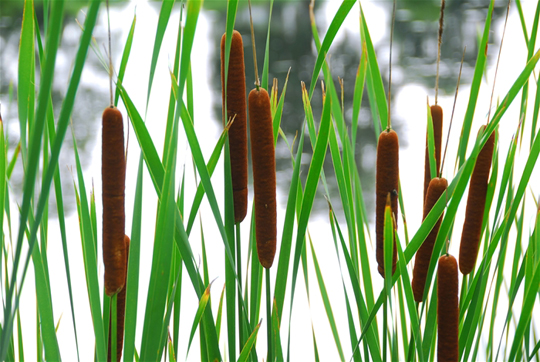Cattails can be found virtually anywhere in the wilderness where there is a water source and are a supermarket full of food and uses that can help ensure your survival.
They can be found growing along streams, rivers, lakes and ponds. The cattail plant (also known as the tule plant) is not only edible and medicinal, it has other uses such as cordage, bedding, insulation, fire tender, shelters, baskets and even hats.

Cattails As Survival Food
The stems a few inches above the soil line in early summer are young and tender and can be peeled and eaten raw or boiled. The roots are great as well, simply pull the lower stalks until the roots break free, peel and eat raw or boil.
The cattail will also develop flower heads that can be eaten by roasting as you would an ear of corn.
By mid to late summer, pollen will collect on the heads and it is easily shaken loose into any container to be used like flour to make breads, pancakes and can be used for thickeners in gravies and sauces.
The roots in late fall and early winter can be mashed and soaked in water to release the starch. The starch will settle on the bottom and will resemble wet flour. Drain the water off and make bread, by adding a little pollen or add to clean water to make soup.
Cattails are an ideal survival food because they are easily recognizable and grow practically anywhere there is fresh water.
As Shelter Material
The green leaves can be cut and woven together into shingle like squares for covering a shelter roof. The material will provide protection from the rain, snow and wind even after it has dried.
Weave a sleeping mat by making two long mats. Connect the mats on one side so it can be folded like a sleeping bag. Before folding over fill one side with pine boughs or other material suitable for sleeping on and then fold the empty half over and tie off so the “stuffing” is secured inside. You can fold the mat up and carry it with you if you have to break camp for another location.
Medicinal Uses
Cattails are truly a survival plant in the truest sense of the word. They not only provide, food, material for shelters and cordage, cattails have several medicinal uses as well. To treat burns, scrapes, insect bites and bruises, split open a cattail root and “bruise” the exposed portion so it can be used as a poultice that can be secured over the injured area.
The ash of burnt cattails is said to have antiseptic properties and many people have used the ashes to treat wounds and abrasions to prevent infection from developing.
If you look closely at the lower stems you will notice an amber or honey like substance that seeps from the stem. Use this secretion to treat small wounds and even toothaches, because it also has antiseptic properties.
Baskets or Packs
You can get creative and weave baskets or small packs for carrying food or other items. Cross a number of leaves together and once you have the base the size you want, fold the remaining pieces up and then weave around the sides to secure the shape. If you need a taller basket, overlap another cattail leaf about four inches before you reach the top of the first row of leaves, so it is caught in several rows of the circular weave around the sides of the basket.
When your container is tall enough, fold the remaining tips over the rim and weave them back through a couple rows of the existing weave to secure them and tear off the excess. You can easily weave handles or straps into the basket/pack to make it easier to carry. The basket will become stronger as the cattail leaves dry and harden.
As Cordage
Peel strips from the leaves and allow them to dry somewhat. Once dried, braid at least three strips together to create a line for fishing or use in shelter building to tie a pole or brush framework together and to attach your woven mats to the frame of your shelter. Start covering the shelter from the bottom and work up, overlapping each mat a couple inches. Then if it rains, the water will run off the outside of the mats.
Fire Starting and Insulation
The head of the cattail after it has turned dark brown will have “fluff” inside, which is excellent tinder. Even after a rain the tinder may still be dry inside the head and if not remove and place in a pocket to dry out by allowing the clothing to absorb the moisture as long as the weather is warm.
The fluff can also be used as insulation for hats and shoes and if you have enough of it, you could make pillows and even stuff a poncho or tarp to make a mattress. It also works great in a baby’s diaper to absorb wetness.
The head can also be covered in pine resin to make a torch. Cut off enough of the stalk for a long handle with the head attached. Roll the head in pine resin and light when needed. Not only will this provide you with light at night, it is a good way to transport fire from one location to another when you have to move camp.
Nitro-Pak has the most complete & affordable selection of emergency preparedness & food storage products in the world. Visit